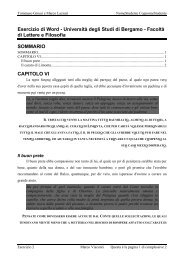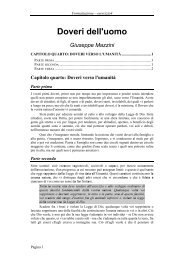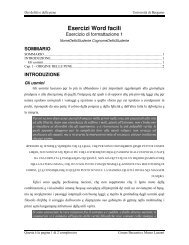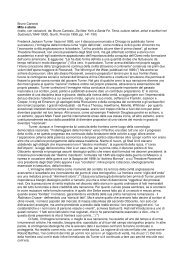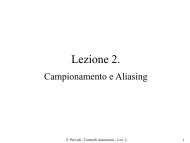- Page 1 and 2:
Ettore Majorana: Appunti di Fisica
- Page 3 and 4:
Indice Prefazione vii Volumetto 1:
- Page 5 and 6:
Volumetto 2: 23 aprile 1928 93 2.1
- Page 7 and 8:
Volumetto 4: 24 aprile 1930 351 4.1
- Page 9 and 10:
Prefazione Introduzione storico-bio
- Page 11 and 12:
Prefazione muniti di indici, ma anc
- Page 13 and 14:
Prefazione sua abituale energia in
- Page 15 and 16:
Prefazione I primi articoli, redatt
- Page 17 and 18:
Prefazione essi avevano scoperto il
- Page 19 and 20:
Prefazione delle “matrici di Dira
- Page 21 and 22:
Prefazione La parte cosí sopravvis
- Page 23 and 24:
Questo volume Prefazione Nel presen
- Page 25 and 26:
Ringraziamenti Prefazione I curator
- Page 27 and 28:
Prefazione uniti; Roma, 1972); e in
- Page 29 and 30:
VOLUMETTO 1 8 marzo 1927 1.1 Potenz
- Page 31 and 32:
Volumetto 1: 8 marzo 1927 se 1+dα
- Page 33 and 34:
0 Volumetto 1: 8 marzo 1927 raggi r
- Page 35 and 36:
Volumetto 1: 8 marzo 1927 1.4 Effet
- Page 37 and 38:
Volumetto 1: 8 marzo 1927 Invece il
- Page 39 and 40:
Volumetto 1: 8 marzo 1927 la quanti
- Page 41 and 42:
Volumetto 1: 8 marzo 1927 1.7 Attra
- Page 43 and 44:
1.8 Formulario Volumetto 1: 8 marzo
- Page 45 and 46:
Volumetto 1: 8 marzo 1927 (compless
- Page 47 and 48:
[ ] 10 Volumetto 1: 8 marzo 1927 1.
- Page 49 and 50:
Volumetto 1: 8 marzo 1927 alla dens
- Page 51 and 52:
da cui per la (1.107) si deduce Vol
- Page 53 and 54:
Volumetto 1: 8 marzo 1927 1.12 Skin
- Page 55 and 56:
Volumetto 1: 8 marzo 1927 del cerch
- Page 57 and 58:
tuite le altre: Volumetto 1: 8 marz
- Page 59 and 60:
Volumetto 1: 8 marzo 1927 nei punti
- Page 61 and 62:
Volumetto 1: 8 marzo 1927 1.17 Scar
- Page 63 and 64:
Volumetto 1: 8 marzo 1927 1.18 Auto
- Page 65 and 66:
Volumetto 1: 8 marzo 1927 La compon
- Page 67 and 68:
Volumetto 1: 8 marzo 1927 la bobina
- Page 69 and 70:
Volumetto 1: 8 marzo 1927 (3) Media
- Page 71 and 72:
Volumetto 1: 8 marzo 1927 (13) cos
- Page 73 and 74:
Volumetto 1: 8 marzo 1927 che si de
- Page 75 and 76:
totale avremo: 15 Volumetto 1: 8 ma
- Page 77 and 78:
Volumetto 1: 8 marzo 1927 l’event
- Page 79 and 80:
Volumetto 1: 8 marzo 1927 La differ
- Page 81 and 82:
Volumetto 1: 8 marzo 1927 L1 = L2,
- Page 83 and 84:
1 p Volumetto 1: 8 marzo 1927 T = T
- Page 85 and 86:
Volumetto 1: 8 marzo 1927 Poiché s
- Page 87 and 88:
e quindi: Volumetto 1: 8 marzo 1927
- Page 89 and 90:
Volumetto 1: 8 marzo 1927 cioè, se
- Page 91 and 92:
1 T = p T0 Volumetto 1: 8 marzo 192
- Page 93 and 94:
Volumetto 1: 8 marzo 1927 cioè a m
- Page 95 and 96:
Volumetto 1: 8 marzo 1927 di densit
- Page 97 and 98:
Volumetto 1: 8 marzo 1927 1.35 Casi
- Page 99 and 100:
Volumetto 1: 8 marzo 1927 Il potenz
- Page 101 and 102:
Volumetto 1: 8 marzo 1927 su una ma
- Page 103 and 104:
Volumetto 1: 8 marzo 1927 s ɛ η 1
- Page 105 and 106:
(8) π 0 Volumetto 1: 8 marzo 1927
- Page 107 and 108:
Volumetto 1: 8 marzo 1927 ottenere
- Page 109 and 110:
Volumetto 1: 8 marzo 1927 che forni
- Page 111 and 112:
(c) se s = i (d) se r = s = i Volum
- Page 113 and 114:
Volumetto 1: 8 marzo 1927 delle fun
- Page 115 and 116:
Volumetto 1: 8 marzo 1927 e se si a
- Page 117 and 118:
Volumetto 1: 8 marzo 1927 indipende
- Page 119:
Volumetto 1: 8 marzo 1927 1.43 ∆
- Page 122 and 123:
Volumetto 2: 23 aprile 1928 essendo
- Page 124 and 125:
Volumetto 2: 23 aprile 1928 La cond
- Page 126 and 127:
Volumetto 2: 23 aprile 1928 Tutti i
- Page 128 and 129:
Volumetto 2: 23 aprile 1928 e poich
- Page 130 and 131:
Volumetto 2: 23 aprile 1928 2.6 Qua
- Page 132 and 133:
Avremo e al limite per x grandissim
- Page 134 and 135:
Volumetto 2: 23 aprile 1928 in acco
- Page 136 and 137:
Volumetto 2: 23 aprile 1928 su una
- Page 138 and 139:
= − = − dpx dτ e 1 − v 2 /c
- Page 140 and 141:
Posto: 8 si trova: du dt = Se invec
- Page 142 and 143:
Volumetto 2: 23 aprile 1928 in cui
- Page 144 and 145:
Volumetto 2: 23 aprile 1928 Il p-es
- Page 146 and 147:
Volumetto 2: 23 aprile 1928 minore
- Page 148 and 149:
Volumetto 2: 23 aprile 1928 Se inve
- Page 150 and 151:
Volumetto 2: 23 aprile 1928 statist
- Page 152 and 153:
Volumetto 2: 23 aprile 1928 x x 5 6
- Page 154 and 155:
x x 6 4.1 4750.1 4.2 5489. 4.3 6321
- Page 156 and 157:
x x 7 7.1 909512. 7.2 1003061.3 7.3
- Page 158 and 159:
posto: Volumetto 2: 23 aprile 1928
- Page 160 and 161:
Volumetto 2: 23 aprile 1928 Se a =
- Page 162 and 163:
Volumetto 2: 23 aprile 1928 l’ene
- Page 164 and 165:
Volumetto 2: 23 aprile 1928 L’Ham
- Page 166 and 167:
Volumetto 2: 23 aprile 1928 Se Ws i
- Page 168 and 169:
Volumetto 2: 23 aprile 1928 e quind
- Page 170 and 171:
Volumetto 2: 23 aprile 1928 Questa
- Page 172 and 173:
Volumetto 2: 23 aprile 1928 e, poic
- Page 174 and 175:
Volumetto 2: 23 aprile 1928 e il va
- Page 176 and 177:
e ponendo 36 cioè: Volumetto 2: 23
- Page 178 and 179:
e quindi: Volumetto 2: 23 aprile 19
- Page 180 and 181:
= Volumetto 2: 23 aprile 1928 r 2
- Page 182 and 183:
Volumetto 2: 23 aprile 1928 Per θ
- Page 184 and 185:
Volumetto 2: 23 aprile 1928 Facciam
- Page 186 and 187:
Segue che se n = 0, ˙α = n = −1
- Page 188 and 189:
Ora e quindi Volumetto 2: 23 aprile
- Page 190 and 191:
(19) ∞ (14bis) Volumetto 2: 23 a
- Page 192 and 193:
Volumetto 2: 23 aprile 1928 essendo
- Page 194 and 195:
Volumetto 2: 23 aprile 1928 da zero
- Page 196 and 197:
Volumetto 2: 23 aprile 1928 Potremo
- Page 198 and 199:
Volumetto 2: 23 aprile 1928 schemat
- Page 200 and 201:
Se si pone Volumetto 2: 23 aprile 1
- Page 202 and 203:
ovvero ponendo P1 = −P , y = 1 4
- Page 204 and 205:
Volumetto 2: 23 aprile 1928 essendo
- Page 206 and 207:
Volumetto 2: 23 aprile 1928 e le eq
- Page 208 and 209:
e, in generale, sarà: Volumetto 2:
- Page 210 and 211:
Volumetto 2: 23 aprile 1928 A ripro
- Page 212 and 213:
Volumetto 2: 23 aprile 1928 Per x >
- Page 214 and 215:
Volumetto 2: 23 aprile 1928 che rap
- Page 216 and 217:
essendo: e poiché: Inoltre: 50
- Page 218 and 219:
Volumetto 2: 23 aprile 1928 partice
- Page 220 and 221:
vita media T : 54 Volumetto 2: 23 a
- Page 222 and 223:
Volumetto 2: 23 aprile 1928 × exp
- Page 224 and 225:
Volumetto 2: 23 aprile 1928 e ciò,
- Page 226 and 227:
sostituendo nella (2.608) otteniamo
- Page 228 and 229:
Volumetto 2: 23 aprile 1928 e ricor
- Page 230 and 231:
In particolare: cE0 = = Volumetto 2
- Page 232 and 233:
Volumetto 2: 23 aprile 1928 Vogliam
- Page 234 and 235:
Volumetto 2: 23 aprile 1928 secondo
- Page 236 and 237:
Volumetto 2: 23 aprile 1928 O σ ov
- Page 238 and 239:
Volumetto 2: 23 aprile 1928 2.38 De
- Page 240 and 241:
Infatti: b a = 1 2 Volumetto 2: 23
- Page 242 and 243:
se deve essere P ′ y0 = 0, abbiam
- Page 244 and 245:
Volumetto 2: 23 aprile 1928 n 16 1
- Page 246 and 247:
(vedi paragrafo 1.32); Volumetto 2:
- Page 248 and 249:
Volumetto 2: 23 aprile 1928 permett
- Page 250 and 251:
Volumetto 2: 23 aprile 1928 Si noti
- Page 252 and 253:
Sn = ∞ r=0 Volumetto 2: 23 aprile
- Page 255 and 256:
VOLUMETTO 3 28 giugno 1929 3.1 Somm
- Page 257 and 258:
Volumetto 3: 28 giugno 1929 (b) la
- Page 259 and 260:
Segue per la (3.14): Volumetto 3: 2
- Page 261 and 262:
Volumetto 3: 28 giugno 1929 Se le e
- Page 263 and 264:
Volumetto 3: 28 giugno 1929 ovvero,
- Page 265 and 266:
Volumetto 3: 28 giugno 1929 Deve qu
- Page 267 and 268:
Volumetto 3: 28 giugno 1929 Sostitu
- Page 269 and 270:
Il punto Volumetto 3: 28 giugno 192
- Page 271 and 272:
Volumetto 3: 28 giugno 1929 Indican
- Page 273 and 274:
la (3.141) diventa: 67 Volumetto 3:
- Page 275 and 276:
e per la (3.151): Volumetto 3: 28 g
- Page 277 and 278:
Segue: Volumetto 3: 28 giugno 1929
- Page 279 and 280:
Volumetto 3: 28 giugno 1929 3.4 Det
- Page 281 and 282:
Si avrà: y = 1 π = 1 π Volumetto
- Page 283 and 284:
= come si era supposto. Volumetto 3
- Page 285 and 286:
Sostituendo in (3.194): z = = ∞ 0
- Page 287 and 288:
t D’altronde: t 0 Volumetto 3: 2
- Page 289 and 290:
Seguono i momenti: µn = In partic
- Page 291 and 292:
cioè: In altre parole: y(k) = π 2
- Page 293 and 294:
Volumetto 3: 28 giugno 1929 Si può
- Page 295 and 296:
(3) Volumetto 3: 28 giugno 1929 Se
- Page 297 and 298:
Volumetto 3: 28 giugno 1929 B11(x)
- Page 299 and 300:
Volumetto 3: 28 giugno 1929 [sin θ
- Page 301 and 302:
Volumetto 3: 28 giugno 1929 Y 2 =
- Page 303 and 304:
Volumetto 3: 28 giugno 1929 3.10 Gr
- Page 305 and 306:
Volumetto 3: 28 giugno 1929 che chi
- Page 307 and 308:
Volumetto 3: 28 giugno 1929 3.12 Po
- Page 309 and 310:
sarà: Volumetto 3: 28 giugno 1929
- Page 311 and 312:
Analogamente si trova: Volumetto 3:
- Page 313 and 314:
Volumetto 3: 28 giugno 1929 E così
- Page 315 and 316:
Sarà in conseguenza: Volumetto 3:
- Page 317 and 318:
Volumetto 3: 28 giugno 1929 Dalle u
- Page 319 and 320:
• j = 0 • j = 1 2 P1 = • j =
- Page 321 and 322:
Volumetto 3: 28 giugno 1929 × j(j
- Page 323 and 324:
Volumetto 3: 28 giugno 1929 Annulla
- Page 325 and 326:
Differenziando si ricava: Volumetto
- Page 327 and 328:
Volumetto 3: 28 giugno 1929 con che
- Page 329 and 330:
cioè: Volumetto 3: 28 giugno 1929
- Page 331 and 332:
• j = 0 • j = 1 2 Rz i = • j
- Page 333 and 334:
Ry i = • j = 3 Rx i = Ry i = ⎛
- Page 335 and 336:
Volumetto 3: 28 giugno 1929 due var
- Page 337 and 338:
Volumetto 3: 28 giugno 1929 le matr
- Page 339 and 340:
Volumetto 3: 28 giugno 1929 di tras
- Page 341 and 342:
Volumetto 3: 28 giugno 1929 Perché
- Page 343 and 344:
α3 = α4 = α5 = α2 = Volumetto 3
- Page 345 and 346:
Volumetto 3: 28 giugno 1929 possibi
- Page 347 and 348:
Volumetto 3: 28 giugno 1929 l’ult
- Page 349 and 350:
Volumetto 3: 28 giugno 1929 Tali fu
- Page 351 and 352:
Volumetto 3: 28 giugno 1929 (i, k =
- Page 353 and 354:
Volumetto 3: 28 giugno 1929 (δH21
- Page 355 and 356:
Volumetto 3: 28 giugno 1929 = 4m2c
- Page 357 and 358:
Volumetto 3: 28 giugno 1929 j2 = k
- Page 359 and 360:
Volumetto 3: 28 giugno 1929 Detta m
- Page 361 and 362:
Volumetto 3: 28 giugno 1929 3.21 Re
- Page 363 and 364:
Volumetto 3: 28 giugno 1929 inequiv
- Page 365 and 366:
cioè: Volumetto 3: 28 giugno 1929
- Page 367 and 368:
Volumetto 3: 28 giugno 1929 con l
- Page 369 and 370:
Gli autovalori di (3.669) sono: −
- Page 371 and 372:
Volumetto 3: 28 giugno 1929 L’aut
- Page 373 and 374:
Volumetto 3: 28 giugno 1929 3.23 Si
- Page 375 and 376:
Volumetto 3: 28 giugno 1929 Siano F
- Page 377:
Volumetto 3: 28 giugno 1929 sostitu
- Page 380 and 381:
da cui confrontando con (4.2): Volu
- Page 382 and 383:
Volumetto 4: 24 aprile 1930 4.2 Pro
- Page 384 and 385:
Volumetto 4: 24 aprile 1930 Lo stat
- Page 386 and 387:
Volumetto 4: 24 aprile 1930 cangian
- Page 388 and 389:
E = − 1 2 Z2 − 9 4Z λ = Volume
- Page 390 and 391:
Volumetto 4: 24 aprile 1930 4.4 Reg
- Page 392 and 393:
Volumetto 4: 24 aprile 1930 la funz
- Page 394 and 395:
Volumetto 4: 24 aprile 1930 Resta d
- Page 396 and 397:
Volumetto 4: 24 aprile 1930 Se in (
- Page 398 and 399:
Volumetto 4: 24 aprile 1930 f = 3 (
- Page 400 and 401:
Volumetto 4: 24 aprile 1930 Partiti
- Page 402 and 403:
Volumetto 4: 24 aprile 1930 f = 7 7
- Page 404 and 405:
Volumetto 4: 24 aprile 1930 Sostitu
- Page 406 and 407:
Eliminando θ: Volumetto 4: 24 apri
- Page 408 and 409:
Volumetto 4: 24 aprile 1930 Il nume
- Page 410 and 411:
Volumetto 4: 24 aprile 1930 essendo
- Page 412 and 413:
Volumetto 4: 24 aprile 1930 Integra
- Page 414 and 415:
Volumetto 4: 24 aprile 1930 Sceglie
- Page 416 and 417: Volumetto 4: 24 aprile 1930 essendo
- Page 418 and 419: Volumetto 4: 24 aprile 1930 Infatti
- Page 420 and 421: Volumetto 4: 24 aprile 1930 × ∞
- Page 422 and 423: Volumetto 4: 24 aprile 1930 gruppo.
- Page 424 and 425: 4.15 Formole Volumetto 4: 24 aprile
- Page 426 and 427: Volumetto 4: 24 aprile 1930 4.16 On
- Page 428 and 429: Volumetto 4: 24 aprile 1930 scambia
- Page 430 and 431: s c z s a x s b x s c x s a y = = =
- Page 432 and 433: γ a 1 γ b 1 γ c 1 = = = (iii) γ
- Page 434 and 435: γ c y = ⎛ ⎜ ⎝ 2 py mc B + B
- Page 436 and 437: Volumetto 4: 24 aprile 1930 relativ
- Page 438 and 439: troviamo Volumetto 4: 24 aprile 193
- Page 440 and 441: Volumetto 4: 24 aprile 1930 i 2 E -
- Page 442 and 443: e la (4.285) diventa: 1 ρ Volumett
- Page 444 and 445: (2) δ = (3) δ < √ 2r0 k : √ 2
- Page 446 and 447: Volumetto 4: 24 aprile 1930 Da ques
- Page 448 and 449: (5) (6) (7) (8) Sia < F > = F = e
- Page 450 and 451: Volumetto 4: 24 aprile 1930 4.24 Fr
- Page 452 and 453: Avremo allora: Volumetto 4: 24 apri
- Page 454 and 455: ϕ m j,j+1 Volumetto 4: 24 aprile 1
- Page 456 and 457: (s·p) ϕ m j,l = 1 r Volumetto 4:
- Page 458 and 459: Volumetto 4: 24 aprile 1930 detto n
- Page 460 and 461: Volumetto 4: 24 aprile 1930 Conside
- Page 462 and 463: ψ2 = ψ3 = (b) m = 0: ψ1 = ψ2 =
- Page 464 and 465: Volumetto 4: 24 aprile 1930 soluzio
- Page 468 and 469: Volumetto 4: 24 aprile 1930 Sostitu
- Page 470 and 471: Volumetto 4: 24 aprile 1930 Sostitu
- Page 472 and 473: θ = 0 o θ = 30 o θ = 60 o θ = 9
- Page 474 and 475: Volumetto 4: 24 aprile 1930 L’int
- Page 476 and 477: Volumetto 4: 24 aprile 1930 Possiam
- Page 478 and 479: da cui: Z 1 W = 1 N ′ W a = Z 2 W
- Page 480 and 481: ψ1 = e −iEt/ ψW + − I ɛ + i
- Page 482 and 483: + LW N ′ W ɛW Q 2 W Volumetto 4
- Page 484 and 485: Volumetto 4: 24 aprile 1930 così v
- Page 486 and 487: Volumetto 4: 24 aprile 1930 ciò co
- Page 488 and 489: Volumetto 4: 24 aprile 1930 talvolt
- Page 490 and 491: Volumetto 5 Tx Ty − Ty Tx = − S
- Page 492 and 493: Volumetto 5 Nel secondo caso tuttav
- Page 494 and 495: Volumetto 5 in cui, ricordiamo, ψ
- Page 496 and 497: Volumetto 5 e disponendo di un’ar
- Page 498 and 499: Volumetto 5 5.3 Zeri delle funzioni
- Page 500 and 501: s Volumetto 5 L’entropia del gas
- Page 502 and 503: essendo T0 definita da Volumetto 5
- Page 504 and 505: Volumetto 5 Per il sodio atomico (N
- Page 506 and 507: Volumetto 5 P5(x) = 63 8 x5 − 35
- Page 508 and 509: Volumetto 5 Segue che i quadrivetto
- Page 510 and 511: Volumetto 5 ψ † σyφ ∼ Ey + i
- Page 512 and 513: da cui segue: Volumetto 5 Ψ ∗ r
- Page 514 and 515: S 1/2 −1 S −1/2 −1 = = Volume
- Page 516 and 517:
x + iy r S m k + Volumetto 5 1 k
- Page 518 and 519:
Volumetto 5 trasformazioni infinite
- Page 520 and 521:
di scambio: Volumetto 5 [α0, ax] =
- Page 522 and 523:
j, m | bz | j + 1, m > = < j, m | b
- Page 524 and 525:
Volumetto 5 in base alla sua defini
- Page 526 and 527:
Volumetto 5 sarà p una funzione si
- Page 528 and 529:
(2) Soluzione di condizioni ai limi
- Page 530 and 531:
Volumetto 5 componenti vettoriali g
- Page 532 and 533:
(a) onde longitudinali: V L k,j,m =
- Page 534 and 535:
Volumetto 5 da cui segue, sviluppan
- Page 536 and 537:
Volumetto 5 Per t → ∞ tutto l
- Page 538 and 539:
e tenendo conto della (5.207) r j
- Page 540 and 541:
1 n C Per ℓ = 0, si ha ad esempio
- Page 543 and 544:
Indice analitico ammoniaca, frequen
- Page 545 and 546:
funzioni di Bessel, 375, 391, 430,
- Page 547:
skineffect limite, 20, 25 spin, 318



